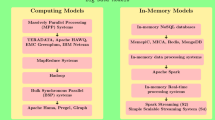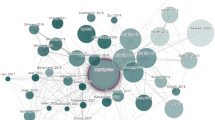Abstract
Clustering a large volume of data in a distributed environment is a challenging issue. Data stored across multiple machines are huge in size, and solution space is large. Genetic algorithm deals effectively with larger solution space and provides better solution. In this paper, we proposed a novel clustering algorithm for distributed datasets, using combination of genetic algorithm (GA) with Mahalanobis distance and k-means clustering algorithm. The proposed algorithm is two phased; in phase 1, GA is applied in parallel on data chunks located across different machines. Mahalanobis distance is used as fitness value in GA, which considers covariance between the data points and thus provides a better representation of initial data. K-means with K-means\( ++ \) initialization is applied in phase 2 on intermediate output to get final result. The proposed algorithm is implemented on Hadoop framework, which is inherently designed to deal with distributed datasets in a fault-tolerant manner. Extensive experiments were conducted for multiple real-life and synthetic datasets to measure performance of our proposed algorithm. Results were compared with MapReduce-based algorithms, mrk-means, parallel k-means and scaling GA.







Similar content being viewed by others
References
Chen CP, Zhang CY (2014) Data-intensive applications, challenges, techniques and technologies: a survey on big data. Inf Sci 275:314–347
IBM, Big Data and Analytics (2015). URL http://www-01.ibm.com/software/data/bigdata/what-is-big-data.html. Accessed 10 Nov 2016
Laney D (2001) 3D data management: controlling data volume, velocity and variety. META Group Res Note 6:70
Hashem IAT, Yaqoob I, Anuar NB, Mokhtar S, Gani A, Khan SU (2015) The rise of big data on cloud computing: review and open research issues. Inf Syst 47:98–115
Jain AK (2010) Data clustering: 50 years beyond K-means. Pattern Recognit Lett 31(8):651–666
Sinha Ankita, Jana PK (2016) Clustering algorithms for big data: a survey, the human element of big data: issues, analytics, and performance. CRC Press, Baca Raton, pp 140–157
Fahad A, Alshatri N, Tari Z, Alamri A, Khalil I, Zomaya AY, Bouras A (2014) A survey of clustering algorithms for big data: taxonomy and empirical analysis. IEEE Trans Emerg Top Comput 2(3):267–279
Tan PN (2006) Introduction to data mining. Pearson Education India, Delhi
De Maesschalck R, Jouan-Rimbaud D, Massart DL (2000) The mahalanobis distance. Chemom Intell Lab Syst 50(1):1–18
Teknomo Kardi (2015) Similarity measurement. http://people.revoledu.com/kardi/tutorial/Similarity/MahalanobisDistance.html. Accessed 10 Nov 2016
Xiang S, Nie F, Zhang C (2008) Learning a Mahalanobis distance metric for data clustering and classification. Pattern Recognit 41(12):3600–3612
Aloise D, Deshpande A, Hansen P, Popat P (2009) NP-hardness of Euclidean sum-of-squares clustering. Mach Learn 75(2):245–248
Drineas P, Frieze A, Kannan R, Vempala S, Vinay V (2004) Clustering large graphs via the singular value decomposition. Mach Learn 56(1–3):9–33
Goldberg DE (2006) Genetic algorithms. Pearson Education India, Delhi
Bhattacharya RK (2012) Introduction to genetic algorithms Department of Civil Engineering. Indian Institute of Technology, Guwahati
Dean J, Ghemawat S (2008) MapReduce: simplified data processing on large clusters. Commun ACM 51(1):107–113
Reddy D, Jana PK, Member IS (2012) Initialization for K-means clustering using Voronoi diagram. Proced Technol 4:395–400
Reddy D, Mishra D, Jana P.K (2011) MST-based cluster initialization for k-means. In: International Conference on Computer Science and Information Technology. Springer Berlin Heidelberg, pp 329–338
Maulik U, Bandyopadhyay S (2000) Genetic algorithm-based clustering technique. Pattern Recognit 33(9):1455–1465
Rahman MA, Islam MZ (2014) A hybrid clustering technique combining a novel genetic algorithm with K-Means. Knowl Based Syst 71:345–365
Zhao W, Ma H, He Q (2009) Parallel k-means clustering based on mapreduce. In: IEEE International Conference on Cloud Computing. Springer Berlin Heidelberg, pp 674–679
Cui X, Zhu P, Yang X, Li K, Ji C (2014) Optimized big data K-means clustering using MapReduce. J Supercomput 70(3):1249–1259
Shahrivari S, Jalili S (2016) Single-pass and linear-time k-means clustering based on MapReduce. Inf Syst 60:1–12
Arthur D, Vassilvitskii S (2007) k-means++: The advantages of careful seeding. In Proceedings of the Eighteenth Annual ACM-SIAM Symposium on Discrete Algorithms. Society for Industrial and Applied Mathematics, pp 1027–1035
HDFS (2016). https://hadoop.apache.org/docs/r1.2.1/hdfs_design.html. Accessed 10 Nov 2016
Verma A, Llor X, Goldberg DE, Campbell RH (2009) Scaling genetic algorithms using mapreduce. In: 2009 IEEE Ninth International Conference on Intelligent Systems Design and Applications, pp 13–18
Banharnsakun A (2017) A MapReduce-based artificial bee colony for large-scale data clustering. Pattern Recognit Lett 93:78–84
Wang J, Yuan D, Jiang M (2012) Parallel K-PSO based on MapReduce. In: 2012 IEEE 14th International Conference on Communication Technology (ICCT), pp 1203–1208
Naldi MC, Campello RJGB (2014) Evolutionary k-means for distributed datasets. Neurocomputing 127:30–42
Apache (2016) Apache hadoop. http://hadoop.apache.org. Accessed 10 Nov 2016
Cant-Paz E (1998) A survey of parallel genetic algorithms. Calculateurs Paralleles Reseaux et Systems Repartis 10(2):141–171
Gong YJ, Chen WN, Zhan ZH, Zhang J, Li Y, Zhang Q, Li JJ (2015) Distributed evolutionary algorithms and their models: a survey of the state-of-the-art. Appl Soft Comput 34:286–300
Mitchell TM (1997) Machine learning. McGraw Hill, New York City
UCI Machine Learning Repository (2016). http://archive.ics.uci.edu/ml/dataset. Accessed 10 Nov 2016
Davies DL, Donald W (1979) Bouldin.: a cluster separation measure. IEEE Trans Pattern Anal Mach Intell 2:224–227
Traganitis PA, Slavakis K, Giannakis GB (2015) Sketch and validate for big data clustering. IEEE J Sel Top Sig Process 9(4):678–690
http://libguides.library.kent.edu/SPSS/PairedSamplestTest. Accessed 10 Nov 2016
Acknowledgements
We sincerely thank the Council of Scientific and Industrial Research (CSIR), New Delhi, India, for supporting this work (File No. 09\(\backslash \)085(0111)2014-EMR-1). We are grateful to CSIR, India, for the financial support.
Author information
Authors and Affiliations
Corresponding author
Rights and permissions
About this article
Cite this article
Sinha, A., Jana, P.K. A hybrid MapReduce-based k-means clustering using genetic algorithm for distributed datasets. J Supercomput 74, 1562–1579 (2018). https://doi.org/10.1007/s11227-017-2182-8
Published:
Issue Date:
DOI: https://doi.org/10.1007/s11227-017-2182-8




